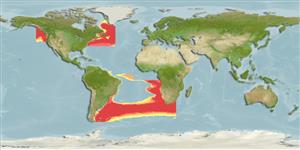Common names from other countries
Teleostei (teleosts) >
Scombriformes (Mackerels) >
Caristiidae (Manefishes)
Etymology: Caristius: Name presumably named after Carystus, a demi-god of Greek mythology..
More on author: Borodin.
Issue
A further revision of caristiid taxonomy will establish the correct genus for the species (see Britz & Hartel, 2012, Ref. 92346).
Environment: milieu / climate zone / depth range / distribution range
Ecology
Marine; bathypelagic; depth range 100 - 420 m (Ref. 6643). Deep-water; 76°N - 56°S, 137°W - 31°E
Atlantic Ocean: off Greenland and Lüderitz, Namibia. Also from Falkland Islands (Ref. 47881). Northeast Pacific: British Columbia, Canada. Western Indian Ocean: off Durban, South Africa.
Size / Weight / Age
Maturity: Lm ? range ? - ? cm
Max length : 30.0 cm TL male/unsexed; (Ref. 6643)
Dorsal spines (total): 0; Dorsal soft rays (total): 31 - 34; Anal spines: 0; Anal soft rays: 18 - 21; Vertebrae: 35 - 38. This species is distinguished from C. macropus and C. meridionalis. by having fewer and larger teeth (25 or fewer in each jaw and 4-7 in palatine vs. 18 or more and 3-13, respectively) and fewer vertebrae (35-38 vs. 37-41); from C. digitus by the absence of a series of fingerlike papillae inside the opercle (0 or 1 papilla in C. fasciatus), the short conical pharyngeal teeth (vs. elongate pharyngeal teeth), and fewer gill rakers (18-21 vs. 22-26) (Ref. 94277).
Minimum depth reported (Ref. 27121). From catches of mature females and juveniles, spawning apparently occurs on the periphery of subtropical waters (in the Sargasso Sea, in the zone of the Gulf Stream and off the Azores) (Ref. 95096).
Life cycle and mating behavior
Maturities | Reproduction | Spawnings | Egg(s) | Fecundities | Larvae
Britz, R. and K.E. Hartel, 2012. On the synonymy of Caristius groenlandicus Jensen and Pteraclis fasciatus Borodin (Pisces: Caristiidae). Zootaxa 3546:85-88. (Ref. 92346)
IUCN Red List Status (Ref. 130435)
CITES (Ref. 128078)
Not Evaluated
Threat to humans
Harmless
Human uses
Tools
Special reports
Download XML
Internet sources
Estimates based on models
Preferred temperature (Ref.
115969): 4.3 - 11.5, mean 6.4 (based on 74 cells).
Phylogenetic diversity index (Ref.
82804): PD
50 = 0.5039 [Uniqueness, from 0.5 = low to 2.0 = high].
Bayesian length-weight: a=0.01995 (0.00906 - 0.04395), b=3.01 (2.83 - 3.19), in cm Total Length, based on all LWR estimates for this body shape (Ref.
93245).
Trophic level (Ref.
69278): 3.1 ±0.30 se; based on food items.
Fishing Vulnerability (Ref.
59153): Low vulnerability (20 of 100).
